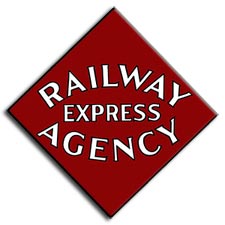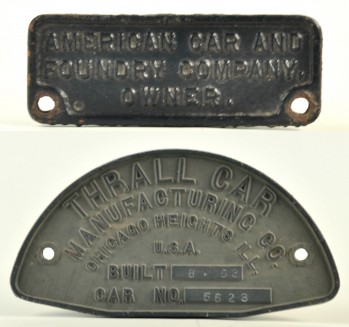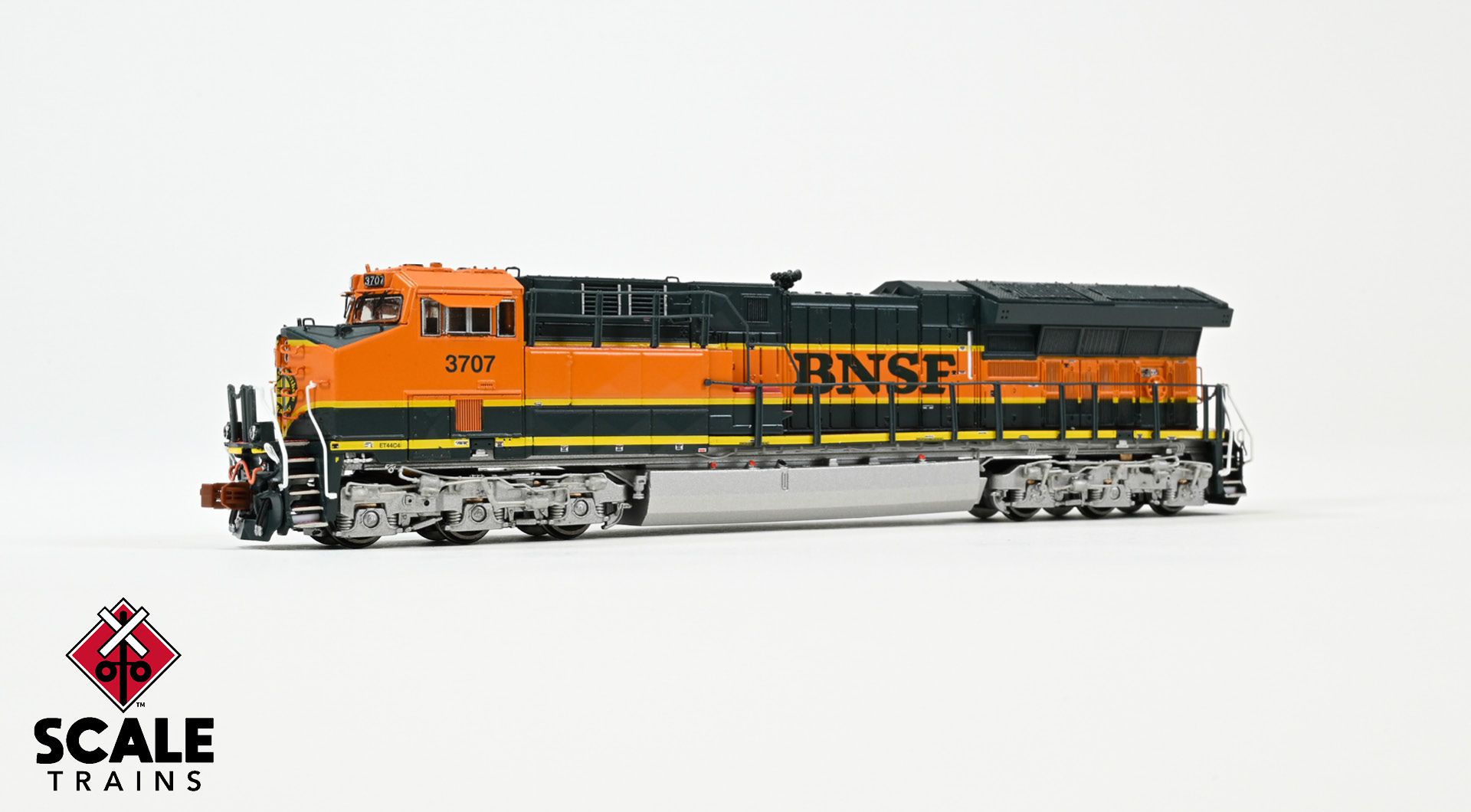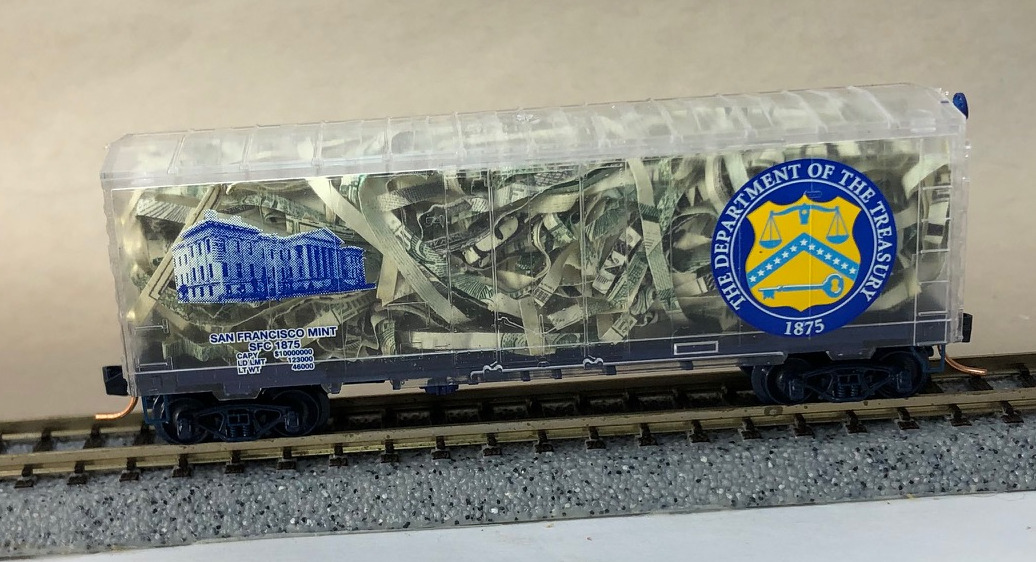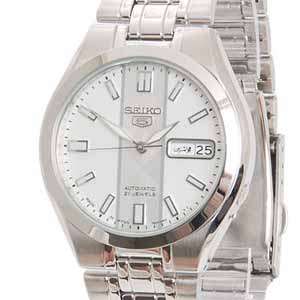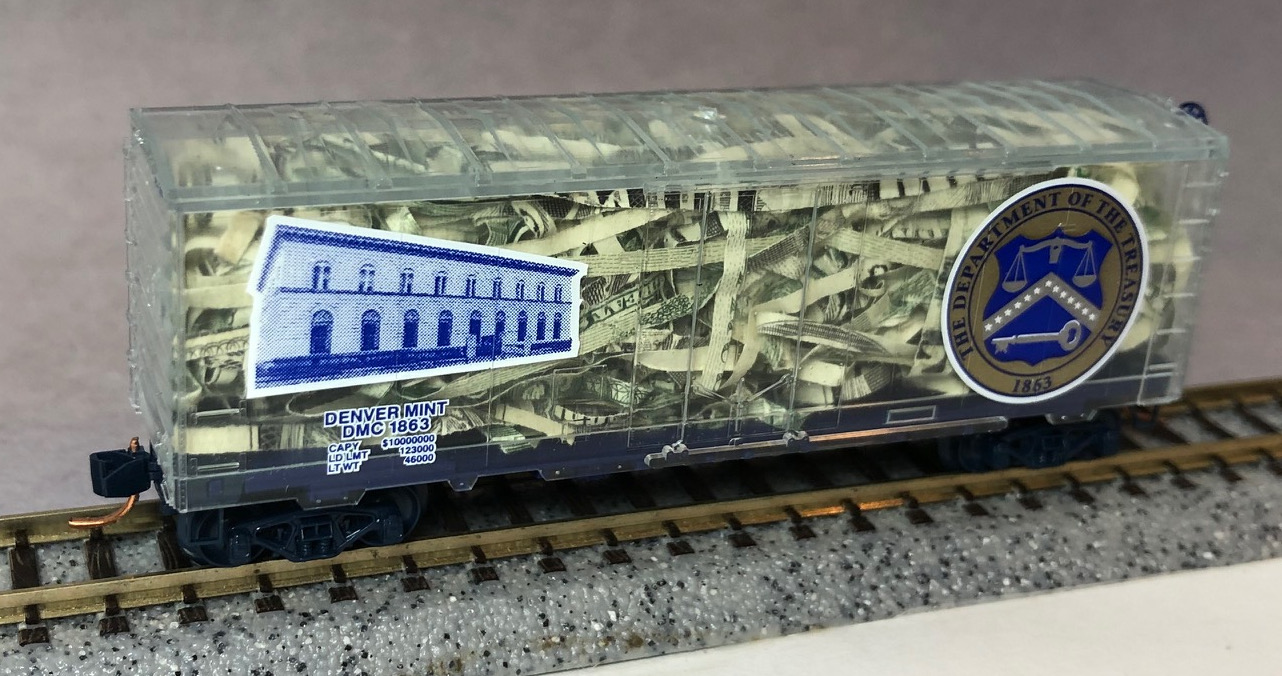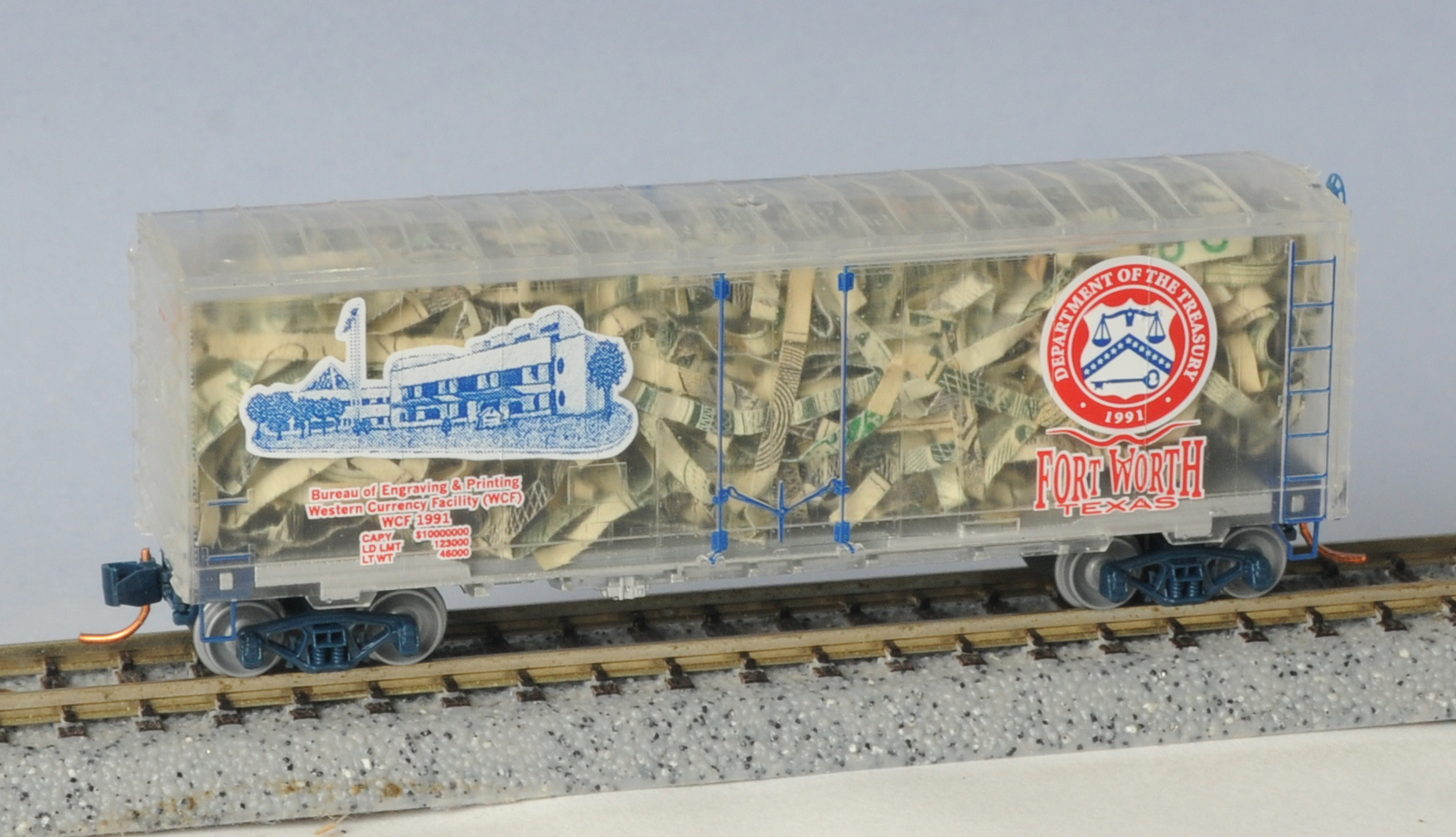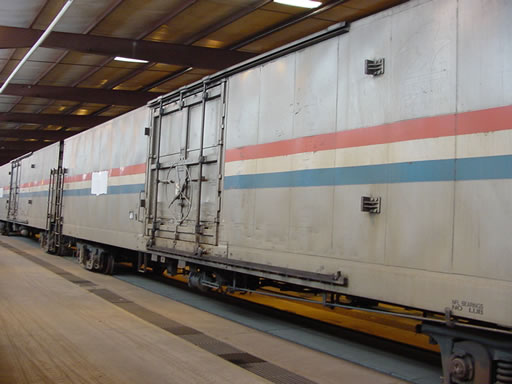Model Information: This model was introduced in 1989 and has been regularly re-run since then. It features trucks with metal wheelsets. Initially equipped with Rapido couplers, it was subsequently offered with Con-Cor dummy knuckle couplers, and then with Micro-Trains knuckle couplers.
This model is based on Amtrak MHC-1 design of 1986. It has been available in Amtrak phase III, IV and V paint schemes, and as well in REA Express car paint scheme.
The only prototypically correct models are the Amtrak 1400-series of the MHC-1. Amtrak 1500-series are MHC-2; Amtrak 70000- and 71000-series are standard boxcars; Amtrak 74000-series 'ExpressTrak' are reefers.
This model is based on Amtrak MHC-1 design of 1986. It has been available in Amtrak phase III, IV and V paint schemes, and as well in REA Express car paint scheme.
The only prototypically correct models are the Amtrak 1400-series of the MHC-1. Amtrak 1500-series are MHC-2; Amtrak 70000- and 71000-series are standard boxcars; Amtrak 74000-series 'ExpressTrak' are reefers.
Prototype History: Late in the 1980's, Amtrak's California Zephyr trains began to run new box cars called "material handling cars" The original 1400-series MHC-1 cars were built by Thrall in 1986 utilizing rebuilt trucks from former REA express cars with a short wheelbase.The MHC cars had pass-through cabling for HEP and usually operated on the head end of the train. The Southwest Chief usually had four or five daily. The MHCs were used primarily for handling bulk mail.
In 1989 Amtrak began receiving a second version of the MHC, the MHC-2, which carry road numbers in the 1500-series. These cars differed in some notable ways. The trucks were a new design that had a longer wheelbase than the earlier cars. Further, there was a body snubber anchor mounted on the sides of the car above each truck. These two details are the most obvious differences between the two car series, however the body and roof are entirely different from the earlier cars.
Unfortunately, the express-freight business indeed turned out to be a loser, particularly because Amtrak could not manage to complete the network expansion that it announced when it started handling the traffic. That resulted in the conventional boxcars, and later the ExpressTrak reefers, being parked in 2003.
Read more on UtahRails.com.
In 1989 Amtrak began receiving a second version of the MHC, the MHC-2, which carry road numbers in the 1500-series. These cars differed in some notable ways. The trucks were a new design that had a longer wheelbase than the earlier cars. Further, there was a body snubber anchor mounted on the sides of the car above each truck. These two details are the most obvious differences between the two car series, however the body and roof are entirely different from the earlier cars.
Unfortunately, the express-freight business indeed turned out to be a loser, particularly because Amtrak could not manage to complete the network expansion that it announced when it started handling the traffic. That resulted in the conventional boxcars, and later the ExpressTrak reefers, being parked in 2003.
Read more on UtahRails.com.
Road Name History: The Railway Express Agency (REA) was a national monopoly set up by the United States federal government in 1917. Rail express services provided small package and parcel transportation using the extant railroad infrastructure much as UPS functions today using the road system. The United States government was concerned about the rapid, safe movement of parcels, money, and goods during World War I and REA was its solution to this problem. REA ceased operations in 1975, when its business model ceased to be viable.
The first parcel express agency in the United States is generally considered to have been started by William Frederick Harnden (1812-1845), who in 1839 began regular trips between New York City and Boston, Massachusetts as a courier transporting small parcels, currency and other valuables. William G. Fargo, a New York Central freight clerk at Auburn, N.Y., and Henry Wells, a leather worker at Batavia, N.Y., organized Wells Fargo & Co. in 1853. Other parcel express pioneers include Henry B. Plant, who formed Southern Express Company, Alvin Adams who founded Adams Express Company, and John Warren Butterfield. Express delivery in the early 19th century was virtually all done via horse, either via stagecoach or by riders. Ad for a railroad, showing American Railway Express service along the line. 1922
The express business flourished in the latter half of the 19th century, and by 1900 there were four principal parcel express companies, all of which included the rapidly advancing railways as one of their means of transport: Adams Express Company, Southern Express Company, American Express Company, and Wells Fargo. In 1913 the U.S. Post Office introduced its Parcel Post service, which offered major competition for the express companies. Despite this, private railway express business increased steadily through the end of World War I.
During World War I, the United States Railroad Administration (USRA) took over the nation's railroads. Under the USRA, the four major and three minor express companies were consolidated as American Railway Express, Inc., save the portion of Southern Express that operated over the Southern Railway and the Mobile & Ohio. Railway Express Agency office, San Augustine, Texas, 1939 REA electric truck circa 1920.
In March 1929, the assets and operations of American Railway Express Inc. were transferred to Railway Express Agency (REA). REA was owned by 86 railroads in proportion to the express traffic on their lines - no one railroad or group of railroads had control of the agency. In response to customer demand, REA added a Chicago, Illinois-based refrigerator car line. In 1927, REA began an Air Express Division. In 1938, the remainder of Southern Express also joined the consolidated REA.
The first parcel express agency in the United States is generally considered to have been started by William Frederick Harnden (1812-1845), who in 1839 began regular trips between New York City and Boston, Massachusetts as a courier transporting small parcels, currency and other valuables. William G. Fargo, a New York Central freight clerk at Auburn, N.Y., and Henry Wells, a leather worker at Batavia, N.Y., organized Wells Fargo & Co. in 1853. Other parcel express pioneers include Henry B. Plant, who formed Southern Express Company, Alvin Adams who founded Adams Express Company, and John Warren Butterfield. Express delivery in the early 19th century was virtually all done via horse, either via stagecoach or by riders. Ad for a railroad, showing American Railway Express service along the line. 1922
The express business flourished in the latter half of the 19th century, and by 1900 there were four principal parcel express companies, all of which included the rapidly advancing railways as one of their means of transport: Adams Express Company, Southern Express Company, American Express Company, and Wells Fargo. In 1913 the U.S. Post Office introduced its Parcel Post service, which offered major competition for the express companies. Despite this, private railway express business increased steadily through the end of World War I.
During World War I, the United States Railroad Administration (USRA) took over the nation's railroads. Under the USRA, the four major and three minor express companies were consolidated as American Railway Express, Inc., save the portion of Southern Express that operated over the Southern Railway and the Mobile & Ohio. Railway Express Agency office, San Augustine, Texas, 1939 REA electric truck circa 1920.
In March 1929, the assets and operations of American Railway Express Inc. were transferred to Railway Express Agency (REA). REA was owned by 86 railroads in proportion to the express traffic on their lines - no one railroad or group of railroads had control of the agency. In response to customer demand, REA added a Chicago, Illinois-based refrigerator car line. In 1927, REA began an Air Express Division. In 1938, the remainder of Southern Express also joined the consolidated REA.
Brand/Importer Information: Con-Cor has been in business since 1962. Many things have changed over time as originally they were a complete manufacturing operation in the USA and at one time had upwards of 45 employees. They not only designed the models,but they also built their own molds, did injection molding, painting, printing and packaging on their models.
Currently, most of their manufacturing has been moved overseas and now they import 90% of their products as totally finished goods, or in finished components. They only do some incidental manufacturing today within the USA.
Important Note: The Con-Cor product numbering can be very confusing. Please see here in the article how to properly enter Con-Cor stock numbers in the TroveStar database.
Currently, most of their manufacturing has been moved overseas and now they import 90% of their products as totally finished goods, or in finished components. They only do some incidental manufacturing today within the USA.
Important Note: The Con-Cor product numbering can be very confusing. Please see here in the article how to properly enter Con-Cor stock numbers in the TroveStar database.
Item created by: CNW400 on 2020-07-14 14:48:06. Last edited by Alain LM on 2020-08-26 16:18:24
If you see errors or missing data in this entry, please feel free to log in and edit it. Anyone with a Gmail account can log in instantly.
If you see errors or missing data in this entry, please feel free to log in and edit it. Anyone with a Gmail account can log in instantly.




